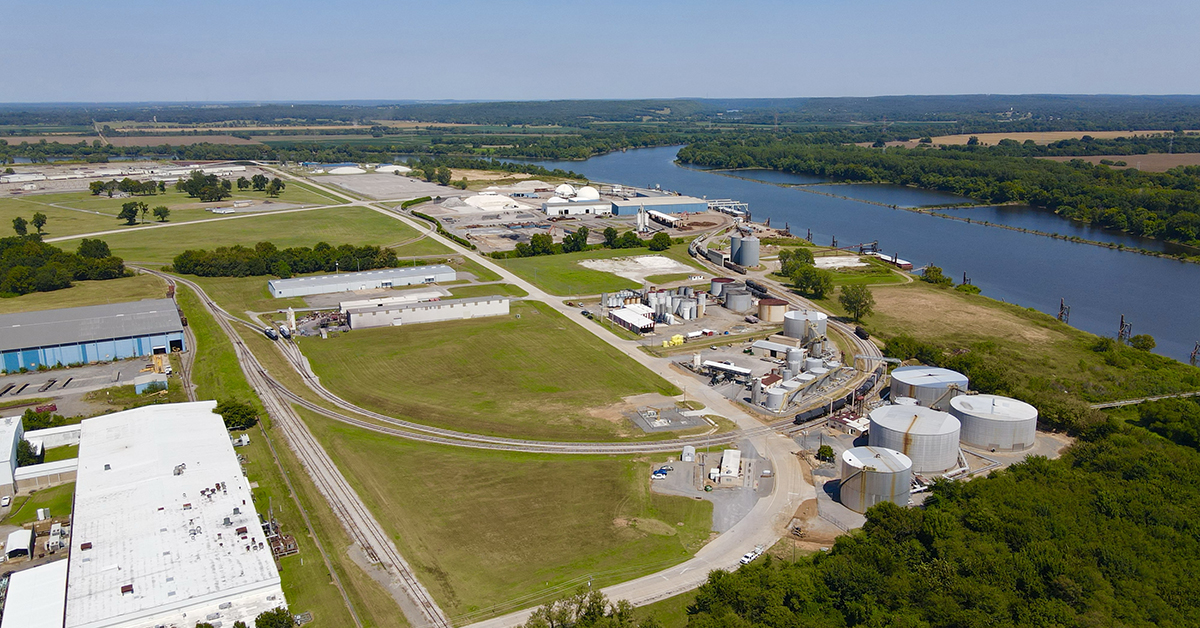Port Muskogee: Looking Back And Forging Ahead
Port Muskogee got its start “the Oklahoma way,” as Port Director Kimbra Scott explained, with “a bold vision, strong partnerships and a determination to build something that would last for generations.” Established in 1961 with the formation of the Muskogee City-County Port Authority, the port welcomed its first commercial barges in 1971. Situated along the McClellan-Kerr Arkansas River Navigation System, Port Muskogee became a gateway for commerce, connecting eastern Oklahoma with more than 20 states and global markets through its connection to the Mississippi River and the Gulf Coast.
Port Muskogee continues to see the movement of agricultural products, particularly feed ingredients, as well as industrial materials such as cement, sand and aggregates. The port has also experienced strong success with steel and metal products like steel coils and pipes used by local manufacturers. In 2021 alone, more than 136,000 tons of steel coils were moved through Port Muskogee.

“Since its founding, Port Muskogee has transformed from a regional shipping terminal into one of Oklahoma’s most strategically positioned industrial hubs,” said port director Kimbra Scott. “What began as a vision for inland waterway access has grown into a comprehensive logistics network where companies can seamlessly connect by road, rail, runway and river. Over time, the port has expanded its footprint, modernized its infrastructure and diversified the industries it serves, from traditional freight and agriculture to advanced manufacturing, logistics and emerging technologies. We’ve also assumed a broader role as the principal economic development agency for Muskogee, and the results are clear. With major infrastructure investments and the successful attraction of key industrial projects, the port is now a driving force in eastern Oklahoma’s economy.”
Scott highlighted recent advancements by CoreScientific and CoreWeave in artificial intelligence and high-performance computing, as well as Polaris Technologies in Bitcoin data innovation, QLF in advanced feed solutions and Love Bottling in beverage logistics operations. In January, Stardust Power Inc. announced plans for the construction of a battery-grade lithium refinery at Southside Industrial Park West in Muskogee, yet another industrial project for the area.

“Welcoming Stardust Power to Muskogee is a major win for our community,” Scott said. “This was a highly competitive project, and securing it speaks volumes about the readiness of our region and the strength of our industrial assets. These investments are creating lasting opportunities, not just for corporations, but for families, our workforce and small businesses throughout the region.”
When asked about the challenges Port Muskogee has faced, Scott related how the Arkansas River near Muskogee experienced the longest flood documented in 2019, remaining above flood stage for more than 22 days. More than 1,000 homes in Oklahoma alone were affected by the flooding. The port sustained extensive damage to dockside rail, critical equipment and access routes.
“Through state and federal grant support, we’ve rebuilt smarter,” Scott said. “Our post-flood recovery and mitigation efforts include flood protection upgrades, dock and rail replacement and long-term infrastructure enhancements. Record flows [in 2019] exceeding 675,000 cubic feet per second displaced barges, damaged key assets and shut down operations for months. In response, we launched a focused initiative, including levee construction, elevation of key sites, drainage improvements and improved rail and road access. These upgrades will ensure that Port Muskogee remains operational and competitive for decades to come. What could have been a long-term setback became a catalyst for transformational investment. Today, the port is more resilient, more capable and more prepared than ever before.”
Port Muskogee thrives with its use of multimodal connections. Besides its connection to the McClellan-Kerr Arkansas River Navigation System, the port is served by two Class I railroads, Union Pacific And the Burlington Northern Santa Fe, and operates 5.5 miles of shortline rail. The port has connections to U.S. Highway 69, a major north-south route with access to east-west markets via Interstates 40 and 44. Those highway connections allow same-day interstate delivery to 26 states and overnight delivery to 48 states. The port offers air connections to the Muskogee-Davis Field Airport, equipped with a 7,200-foot runway, and the Tulsa International Airport.
Scott attributes the port’s future success to its multimodal connections.
“In 10 years, we envision Port Muskogee as one of the nation’s leading micropolitan logistics hubs, renowned for its seamless multimodal connectivity by river, rail, road and runway, and strategically located at the center of the U.S. supply chain,” Scott said. “We’re actively developing more shovel-ready industrial sites around the port to attract the next generation of industry and investment. With increased cargo throughput, expanded trade routes and stronger commercial partnerships, we aim to unlock new revenue streams and strengthen the port as a primary economic engine, not only for Muskogee but for the entire region. It’s a bold vision, but one that’s within reach. The work is already underway.”
A recently completed $15 million BUILD grant-funded rail project has improved the connection between Union Pacific’s mainline and the port marshaling yard. In addition, phase one of an $11 million-plus flood protection improvement project, including berm construction and the purchase of AquaFence systems to mitigate flood risk, is complete. The fully funded $33 million Waterfront Recovery & Resiliency Project will introduce new dockside rail and a new bulkhead, a main dock replacement along with a new heavy-lift dock, the replacement of three overhead cranes and a new transit warehouse.
Looking ahead, Port Muskogee is pursuing funding for a plan to replace 20 aging mooring dolphins and add two new ones to support barge operations.
“Muskogee is entering a new era, one where families can thrive, businesses can grow and the next generation can build their future right here at home,” Scott said. “Today, Port Muskogee continues to play a vital role in our local and state economy, attracting investment, creating jobs and proving that success truly flows from Muskogee.”



